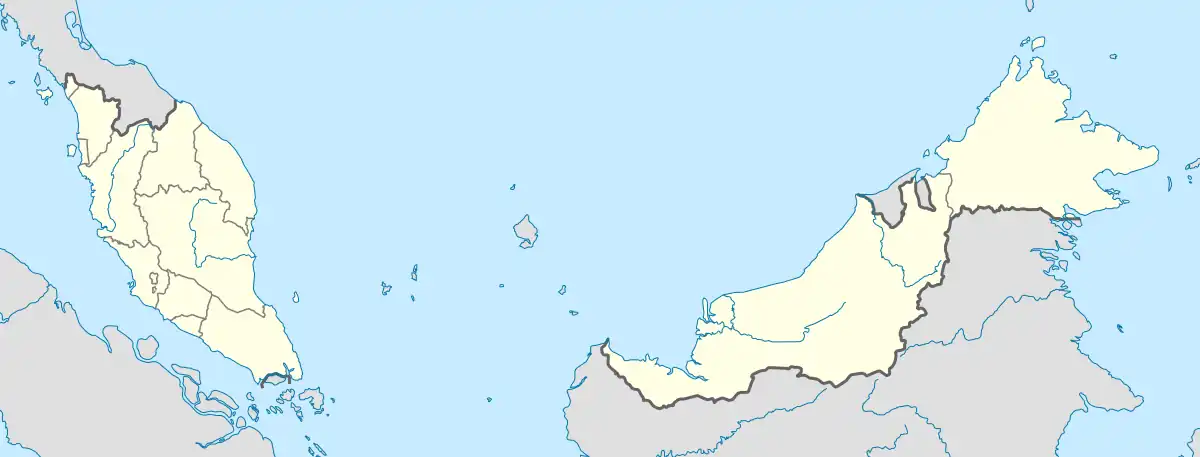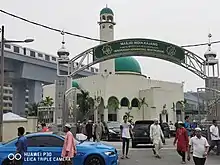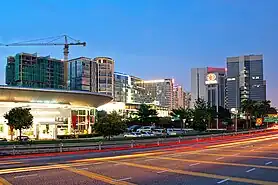Kajang | |
|---|---|
Town | |
| Other transcription(s) | |
| • Jawi | کاجڠ |
| • Chinese | 加影 |
| • Tamil | காஜாங் Kājāṅ (Transliteration) |
 | |
 Seal | |
| Motto(s): Kajang Bandar Pilihan untuk Didiami (Kajang Choice City for Living) | |
Location in Malaysia | |
 Kajang | |
| Coordinates: 2°59′35″N 101°47′20″E / 2.99306°N 101.78889°E | |
| Country | Malaysia |
| State | Selangor |
| Establishment | 1709 |
| Granted municipal status | 1 January 1997 |
| Granted city status | TBA |
| Government | |
| • Yang Di-Pertua (President) | Dato' Haji Rosli bin Othman DPMS |
| Area | |
| • Town | 93.4 km2 (36.1 sq mi) |
| • Urban | 790.43 km2 (305.19 sq mi) |
| Population (2020[1]) | |
| • Town | 236,240 |
| • Density | 1,326/km2 (3,393/sq mi) |
| • Metro | 1,047,356[2] |
| Time zone | UTC+8 (MST) |
| • Summer (DST) | Not observed |
| Postal codes in Malaysia | 43000 43200 43500 43650 |
| Calling code | +60-3-87 +60-3-89 +60-3-90 |
| Website | www |
Kajang is a town in both Hulu Langat District and Sepang District, Selangor, Malaysia. Kajang, along with much of Hulu Langat District, is governed by the Kajang Municipal Council. Some parts of Kajang such as Seksyen 12 Bandar Baru Bangi, Kampung Sungai Merab, Desa Pinggiran Putra and Kampung Dato Abu Bakar Baginda are located in northeast Dengkil, Sepang District and is governed by the Sepang Municipal Council.[3] Kajang town is located on the eastern banks of the Langat River. It is surrounded by Cheras, Semenyih, Bangi, Putrajaya and Serdang.
According to the 2020 census, the local authority area (which includes Kajang, Cheras, Balakong, Bangi, Semenyih and Pekan Hulu Langat) has a population of 1.05 million people.[4]
Etymology
The name Kajang is believed to have originated from the language of Temuan tribes (Orang Asli) who populated the Langat valley in the 17th-18th centuries. In their language kajang referred to their art of weaving screwpine or pandanus leaves, which were prevalent in much of the country. A similar theory stated that settlers from the neighboring domain of Sungai Ujong (Negeri Sembilan) once constructed huts (pondok) in the area with thatched roof made from folded (lipat kajang) screwpine leaves.[5]
It is also believed that the name kajang may have originated from the Buginese word berkajang, meaning camp or accommodation.[6]
Geography and development
Kajang is a half hour's drive from Kuala Lumpur's central business district, primarily through Jalan Cheras and the Grand Saga Expressway; both routes are part of the Malaysia Federal Route 1 system.
The first planned township built and developed in Kajang is Bandar Baru Bangi which was first developed in 1974 by the Selangor state government. It has since acted as the satellite town and Central Business District of Kajang, with most banks and government offices operating out of the township. The Kajang bus and taxi terminal called Hentian Kajang is also located at the eastern end of the township. The district capital of Hulu Langat was shifted to Bandar Baru Bangi from Kajang in 1992.[7]
In recent years, a few townships were developed in Kajang, such as Taman Prima Saujana, Sungai Chua and Taman Kajang Perdana (Kajang Highlands). High-end developments in Kajang include Bandar Seri Putra, Bandar Bukit Mahkota, Twin Palms, Sri Banyan, Country Heights, Jade Hills, Saujana Impian, TTDI Grove, Tropicana Heights and Prima Paramount. Areas surrounding these townships are accessible via the SILK Expressway, Kajang-Seremban Expressway, Grand Saga Expressway and the North–South Expressway Southern Route.
Some parts of Kajang such as Kampung Sungai Merab, Desa Pinggiran Putra and Kampung Dato Abu Bakar Baginda are located in northeast Dengkil, Sepang District and is governed by the Sepang Municipal Council.[8] While technically being a part of Sepang District under Mukim Dengkil, the above-mentioned townships are commonly associated with Kajang due to close proximity to Kajang proper (adjacent to Kampung Sungai Ramal which is separated by the North South Expressway) and the rather lengthy distance from Sepang and Dengkil towns proper. The townships uses the postal code of Kajang instead of Sepang and Dengkil, also due to the reasons above.[9][10][11]
While Bandar Seri Putra and Bukit Mahkota are located adjacent to Bangi Lama (Bangi old town) as well as Bandar Baru Bangi, the townships along with Bangi Lama uses the postal code of Kajang instead of Bandar Baru Bangi. The townships of Bandar Baru Bangi, Bangi Lama, Bandar Seri Putra and Bukit Mahkota are located in Mukim Kajang.[12]
History
Orang Asli tribes had already established settlements in what is now Kajang as early as the 16th century, however the first recorded settlement was found in 1709 by additional Orang Asli settlers who relocated from the Klang valley.[13] Kajang town in its present form was founded in the 1870s, in the aftermath of the Klang War. In its early days, it was settled by Mandailings and Minangkabau people from Sumatra in the then-Dutch East Indies, followed by Chinese tin miners.[14]
As with other towns in Selangor, Kajang as a modern town owes its rise in particular to tin mines and plantations which were opened around the 1890s. A famous coffee estates was Inch Kenneth Estate managed by the Kindersley brothers, who were among the first to plant rubber in the country on a commercial basis.[15]

During the Japanese invasion, Kajang was bombed on 12 January 1942, a day after the fall of Kuala Lumpur. The bombs, meant for the railway station, missed its target, and hit a nearby church instead.[16]
In 1948, a Communist insurgency against British forces and their allies across Malaya began, which led to the Malayan Emergency with fighting soon spreading to Kajang. Guerrilla leader Lau Yew died in combat just outside Kajang in July 1948; British forces photographed his corpse and printed the image onto leaflets to distribute around Kajang.[17]
Kajang was granted municipal status on 1 January 1997. Previously it was under the jurisdiction of the Hulu Langat District Council (Majlis Daerah Hulu Langat, MDHL). Kajang was the administrative centre of the Hulu Langat region until it was relocated to Bandar Baru Bangi in 1992.[18]
Demographics
Kajang's population of 236,240 consists of a wide demographic population.[19]
Kajang's main population centres are Sg. Sekamat, Taman Saujana Impian, Sg. Kantan, Sg. Jelok, Sg. Ramal, Sungai Chua, Jalan Reko, Jalan Bukit, Taman Jenaris, Taman Prima Saujana, Taman Kantan Permai, Taman Kajang Perdana, Taman Sri Ramal, Taman Bukit Mewah, Kajang Prima, Bandar Teknologi Kajang, Hillpark and Bandar Baru Bangi.
Landmarks

The city centre of Kajang is the colonial quarter near the Stadium Kajang MRT station, including the streets of Jalan Mendaling, Jalan Stadium, Jalan Sulaiman and Jalan Raja Haroun. The buildings in the area were constructed around the 1900s to 1930s.[20] The architecture of these shophouses are a combination of traditional Chinese and European designs. The ground floor was used mostly for commercial activities and the upper floor as the family living quarters.

One of Kajang's landmarks is Kajang Stadium which is situated in the heart of the town. The stadium can accommodate up to 5,000 people and is used throughout the year for the community soccer competitions.
Another landmark is the Kajang Jamek Mosque, which is recognisable by its bright yellow facade.
Transportation
Car
Kajang is served by a network of tolled expressways and federal highways.
Federal Route 1, the premier north–south federal route of Peninsular Malaysia, runs through downtown Kajang as Jalan Cheras from Cheras until Sungai Jernih and Stadium Kajang and then southwards as Jalan Semenyih from Stadium Kajang until Semenyih, Beranang and neighbouring Seremban, Negeri Sembilan with the rest of the route terminating in Johor Bahru, Johor - the route's southern terminus. On Federal Route 1, Kajang is 22 km from Kuala Lumpur, 8 km from Semenyih and 43 km from Seremban.
A stretch of Federal Route 1 is concurrent with the Cheras-Kajang toll road (aka the Grand Saga Expressway) between Taman Connaught and Bukit Dukung. The SILK Expressway starts in Serdang, which then runs through Balakong and then forms a beltway around downtown Kajang before ending near Bandar Baru Bangi. It is the main ring road for Kajang.
PLUS Expressway exit 210 (Kajang Interchange) serves the vicinity of Kajang and Bangi. It also links the expressway to SILK Expressway and SKVE Expressway as well as B11 which runs concurrently with SILK and SKVE from SKVE's Serdang Interchange at Seri Kembangan until SILK's Sungai Chua Interchange at Kajang, before being detoured out of SILK after the interchange. B11 continues on its own separate route until its terminus at Stadium Kajang just before the intersection with Jalan Cheras, Jalan Semenyih and Jalan Reko
From Ampang Jaya, one can reach Kajang with state routes B62 and B52.
Public transport
KB06 KG35 Kajang railway station is the principal rail station of Kajang. It is an interchange station between the 9 MRT Kajang Line, 1 KTM Seremban Line and ETS KTM ETS. The station is the southern terminal of the MRT line.
Kajang station, though so named, does not directly serve downtown Kajang; Stadium Kajang MRT is located in the actual downtown area, along with Sungai Jernih MRT.
Food and tourism

Kajang is famous for its satay, a form of skewered barbecued meat. Informally, Kajang is known as the Satay Town.[21]
Government and infrastructure
The Malaysia Prison Complex (Kompleks Penjara Kajang), Prison Department of Malaysia is headquartered in Kajang.[22][23]
Shopping
.jpg.webp)
Kajang has multiple shopping complexes, amongst them is the Billion Shopping Center formerly in Kajang town, which now has relocated to Bandar Teknologi Kajang. Other shopping centres located in Kajang are Plaza Metro Kajang, Metro Point and Kompleks Kota Kajang. Metro Avenue is a new shopping district located opposite SMJK Yu Hua Kajang and Kajang High School.
Facilities and amenities
Hospital Kajang is the primary public hospital in the city.
Private medical centres function 24 hours and include facilities such as Poliklinik MUC @Metro Point, Klinik Mediviron Prima Saujana, Kajang Plaza Medical Centre (KPMC) and KPJ Kajang Specialist Hospital.
The Hulu Langat District Police Headquarters are located in the town centre, across the Highway 1 junction from the Post Office. Federal government agencies with their branch in Kajang include the National Registration Department, Immigration Department, Transportation Department, and Hulu Langat Education Office.
Education

Primary
- Al-Amin Sungai Tangkas
- Rafflesia International School Kajang 2
- SK Bandar Seri Putra
- SK Jalan Bukit 1
- SK Jalan Bukit 2
- SK Jalan Semenyih 1
- SK Jalan Semenyih 2
- SK Kajang
- SK Kajang Utama
- SK Kantan Permai
- SK Leftenan Adnan
- SK Saujana Impian
- SK Saujana Impian 2
- SK Seri Sekamat
- SK Taman Jasmin
- SK Taman Sri Jelok
- SRJK(C) Yu Hua
- SRJK(C) Yu Hua 2 (under construction)
- SRJK(C) Sungai Chua
- SRJK(T) Kajang
- Tanarata International Schools
- SK Convent Kajang
- SK Taman Rakan
Secondary
- Rafflesia International School@Kajang 2
- SMK Convent Kajang
- SM Integrasi Tahfiz Ilmuwan Bangi
- SM Rafflesia@Kajang 2
- SM Teknik Kajang
- SMAP Kajang
- SMJK Yu Hua Kajang
- SMK Jalan Bukit
- SMK Jalan Reko
- SMK Kajang Utama
- SMK Saujana Impian
- SMK Sultan Abdul Aziz Shah (SAAS)
- SMK Sungai Ramal (SEMARAK)
- SMK Taman Jasmin 2
- SMK Tinggi Kajang (Kajang High School)
- SMKA Maahad Hamidiah
- Tanarata International Schools
Tertiary

Kajang is home to institutions of higher learning, which includes:
- Universiti Tunku Abdul Rahman (UTAR) Sungai Long Campus
- Universiti Tenaga Nasional
- Infrastructure University Kuala Lumpur
- New Era University College
- German-Malaysian Institute
- Universiti Kuala Lumpur Malaysia France Institute (MFI)
- Universiti Kuala Lumpur Medical Science and Technology (MESTECH)
Politics

After the 2018 Malaysian general election, Kajang became part of the Bangi parliamentary constituency in the Dewan Rakyat of the Malaysian Parliament. The seat is held by Syahredzan Johan from PH-DAP.
In the Selangor State Legislative Assembly, Kajang is one of three state seats within the Bangi parliamentary district; the other two are Balakong and Sungai Ramal. The incumbent Assemblyperson for Kajang is David Cheong from PH-PKR.
Until 9 May 2018, Kajang was part of the Hulu Langat parliamentary constituency in the Dewan Rakyat of the Malaysian Parliament.
In the Selangor State Legislative Assembly, Kajang was one of three state seats within the Hulu Langat parliamentary district; the other two were Semenyih and Dusun Tua.
Notable people

- Lt Adnan Bin Saidi, Malayan military officer who took part in the Battle of Singapore, Bukit Chandu during World War II.
- Datuk Ramli bin Ibrahim, Malaysian choreographer.[24][25][26]
- Ning Baizura, singer.
- Nora Danish, actress.
- Suresh Navaratnam, Malaysian cricketer, represented Malaysia for 21 years and captained the National Team.
- K. Sanbagamaran, former Selangor FA and Malaysia national football team player.
- Jonathan Ramachandran, represented Malaysia for International Mathematical Olympiad.[27][28][29][30][31]
- D. Christie Jayaseelan, football player.
- K. Reuben, football player.
- Safee Sali, football player.
References
- ↑ "LATAR BELAKANG PEJABAT DAERAH / TANAH HULU LANGAT". Retrieved 27 April 2022.
- ↑ "MyCenDash". Retrieved 1 June 2022.
- ↑ Shaharir, Syahrul Sazli (30 March 2023). "Kampung Sungai Merab (1896)". Cebisan Sejarah Bangi (in Malay).
- ↑ "MyCenDash". Retrieved 1 June 2022.
- ↑ "Kajang kaya warisan sejarah". Berita Harian. Retrieved 27 August 2021.
- ↑ "Asal usul nama Kajang". Sinar Harian. Archived from the original on 20 November 2017. Retrieved 27 August 2021.
- ↑ "Portal Rasmi PDT Hulu Langat Sejarah". www.selangor.gov.my.
- ↑ Shaharir, Syahrul Sazli (30 March 2023). "Kampung Sungai Merab (1896)". Cebisan Sejarah Bangi (in Malay).
- ↑ "Sungai Merab, Kajang - Postcode - 43000 - Malaysia Postcode".
- ↑ "Kampung Dato Abu Bakar Baginda, Kajang - Postcode - 43000 - Malaysia Postcode". postcode.my.
- ↑ "Desa Pinggiran Putra, Kajang - Postcode - 43000 - Malaysia Postcode". postcode.my.
- ↑ "Ulu Langat (District, Malaysia) - Population Statistics, Charts, Map and Location". www.citypopulation.de.
- ↑ "Info Kajang". Kajang Municipal Council. 4 November 2015. Retrieved 27 August 2021.
- ↑ "Kajang bukan sekadar ada sate sedap, tapi punyai sejarah menarik untuk dijelajah". MStar. 21 December 2019. Retrieved 27 August 2021.
- ↑ "It's History: Men who sowed the seeds of country's rubber industry". www.angelfire.com. Retrieved 30 August 2023.
- ↑ "History of Kajang". 15 July 2020. Retrieved 4 April 2021.
- ↑ Hack, Karl (2022). The Malayan Emergency: Revolution and Counterinsurgency at the End of Empire. Cambridge: Cambridge University Press. p. 320.
- ↑ "SEJARAH PEJABAT DAERAH / TANAH HULU LANGAT". Retrieved 27 August 2021.
- ↑ "Population Distribution by Local Authority Areas and Mukims, 2010". Department of Statistics, Malaysia. Archived from the original on 14 November 2014.
- ↑ Pradhan, Biswajeet (8 May 2017). Spatial Modeling and Assessment of Urban Form: Analysis of Urban Growth: From Sprawl to Compact Using Geospatial Data. Springer. ISBN 978-3-319-54217-1.
- ↑ "Progression of a satay town - Focus - The Star Online". thestar.com.my. Retrieved 20 November 2016.
- ↑ "Home." Prison Department of Malaysia. Retrieved on 7 August 2014. "Malaysia Prison Complex, Kajang Selangor." Map.
- ↑ "IBU PEJABAT PENJARA MALAYSIA." Prison Department of Malaysia. Retrieved on 7 August 2014. "Bukit Wira, Beg Berkunci No. 212, 43000 Kajang, SELANGOR DARUL EHSAN"
- ↑ Thayaparan, S. (1 January 2021). "Ramli Ibrahim dances through arts, religion and politics". Malaysiakini. Retrieved 5 January 2023.
- ↑ "Ramli - dancer, arts and culture icon. Born in Kajang". MyHometown. Retrieved 5 January 2023.
- ↑ Mok, Opalyn (17 May 2015). "10 things about: Ramli Ibrahim, champion of Indian classical dance". Malay Mail. Retrieved 5 January 2023.
- ↑ "International Mathematical Olympiad". www.imo-official.org. Retrieved 7 January 2023.
- ↑ "Ex-Olympians". IMO Malaysia. 8 July 2020. Retrieved 7 January 2023.
- ↑ "Persatuan Sains Matematik Malaysia (PERSAMA) - Keputusan Terdahulu". persama.org.my. Retrieved 7 January 2023.
- ↑ "There's no place like home". Retrieved 13 January 2023 – via PressReader.
- ↑ "ABOUT US". Anonymous Christian. Retrieved 13 February 2023.

.jpg.webp)

